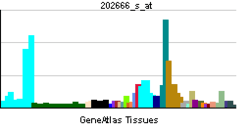ACTL6A
Actin-like protein 6A is a protein that in humans is encoded by the ACTL6A gene.[1][2][3]
Function
This gene encodes a family member of actin-related proteins (ARPs), which share significant amino acid sequence identity to conventional actins. Both actins and ARPs have an actin fold, which is an ATP-binding cleft, as a common feature. The ARPs are involved in diverse cellular processes, including vesicular transport, spindle orientation, nuclear migration and chromatin remodeling. This gene encodes a 53 kDa subunit protein of the BAF (BRG1/brm-associated factor) complex in mammals, which is functionally related to SWI/SNF complex in S. cerevisiae and Drosophila; the latter is thought to facilitate transcriptional activation of specific genes by antagonizing chromatin-mediated transcriptional repression. Together with beta-actin, it is required for maximal ATPase activity of BRG1, and for the association of the BAF complex with chromatin/matrix. Three transcript variants that encode two different protein isoforms have been described.[3]
Interactions
ACTL6A has been shown to interact with SMARCA2,[4][5][6] Myc,[5] Transformation/transcription domain-associated protein,[5] RuvB-like 1[5] and SMARCA4.[1][4]
References
- ↑ 1.0 1.1 Zhao K, Wang W, Rando OJ, Xue Y, Swiderek K, Kuo A et al. (December 1998). "Rapid and phosphoinositol-dependent binding of the SWI/SNF-like BAF complex to chromatin after T lymphocyte receptor signaling". Cell 95 (5): 625–36. doi:10.1016/S0092-8674(00)81633-5. PMID 9845365.
- ↑ Harata M, Mochizuki R, Mizuno S (July 1999). "Two isoforms of a human actin-related protein show nuclear localization and mutually selective expression between brain and other tissues". Biosci Biotechnol Biochem 63 (5): 917–23. doi:10.1271/bbb.63.917. PMID 10380635.
- ↑ 3.0 3.1 "Entrez Gene: ACTL6A actin-like 6A".
- ↑ 4.0 4.1 Wang W, Côté J, Xue Y, Zhou S, Khavari PA, Biggar SR et al. (October 1996). "Purification and biochemical heterogeneity of the mammalian SWI-SNF complex". EMBO J. 15 (19): 5370–82. PMC 452280. PMID 8895581. Vancouver style error (help)
- ↑ 5.0 5.1 5.2 5.3 Park J, Wood MA, Cole MD (March 2002). "BAF53 forms distinct nuclear complexes and functions as a critical c-Myc-interacting nuclear cofactor for oncogenic transformation". Mol. Cell. Biol. 22 (5): 1307–16. doi:10.1128/MCB.22.5.1307-1316.2002. PMC 134713. PMID 11839798.
- ↑ Kuroda Y, Oma Y, Nishimori K, Ohta T, Harata M (November 2002). "Brain-specific expression of the nuclear actin-related protein ArpNalpha and its involvement in mammalian SWI/SNF chromatin remodeling complex". Biochem. Biophys. Res. Commun. 299 (2): 328–34. doi:10.1016/S0006-291X(02)02637-2. PMID 12437990.
Further reading
- Schafer DA, Schroer TA (2000). "Actin-related proteins.". Annu. Rev. Cell Dev. Biol. 15: 341–63. doi:10.1146/annurev.cellbio.15.1.341. PMID 10611965.
- Doyon Y, Côté J (2004). "The highly conserved and multifunctional NuA4 HAT complex.". Curr. Opin. Genet. Dev. 14 (2): 147–54. doi:10.1016/j.gde.2004.02.009. PMID 15196461. Vancouver style error (help)
- Maruyama K, Sugano S (1994). "Oligo-capping: a simple method to replace the cap structure of eukaryotic mRNAs with oligoribonucleotides.". Gene 138 (1–2): 171–4. doi:10.1016/0378-1119(94)90802-8. PMID 8125298.
- Suzuki Y, Yoshitomo-Nakagawa K, Maruyama K, Suyama A, Sugano S (1997). "Construction and characterization of a full length-enriched and a 5'-end-enriched cDNA library". Gene 200 (1–2): 149–56. doi:10.1016/S0378-1119(97)00411-3. PMID 9373149.
- Cho H, Orphanides G, Sun X, Yang XJ, Ogryzko V, Lees E et al. (1998). "A human RNA polymerase II complex containing factors that modify chromatin structure". Mol. Cell. Biol. 18 (9): 5355–63. PMC 109120. PMID 9710619.
- Phelan ML, Sif S, Narlikar GJ, Kingston RE (1999). "Reconstitution of a core chromatin remodeling complex from SWI/SNF subunits". Mol. Cell 3 (2): 247–53. doi:10.1016/S1097-2765(00)80315-9. PMID 10078207.
- Ikura T, Ogryzko VV, Grigoriev M, Groisman R, Wang J, Horikoshi M et al. (2000). "Involvement of the TIP60 histone acetylase complex in DNA repair and apoptosis". Cell 102 (4): 463–73. doi:10.1016/S0092-8674(00)00051-9. PMID 10966108.
- Xue Y, Canman JC, Lee CS, Nie Z, Yang D, Moreno GT et al. (2001). "The human SWI/SNF-B chromatin-remodeling complex is related to yeast rsc and localizes at kinetochores of mitotic chromosomes". Proc. Natl. Acad. Sci. U.S.A. 97 (24): 13015–20. doi:10.1073/pnas.240208597. PMC 27170. PMID 11078522.
- Wiemann S, Weil B, Wellenreuther R, Gassenhuber J, Glassl S, Ansorge W et al. (2001). "Toward a catalog of human genes and proteins: sequencing and analysis of 500 novel complete protein coding human cDNAs". Genome Res. 11 (3): 422–35. doi:10.1101/gr.GR1547R. PMC 311072. PMID 11230166.
- Simpson JC, Wellenreuther R, Poustka A, Pepperkok R, Wiemann S (2001). "Systematic subcellular localization of novel proteins identified by large-scale cDNA sequencing". EMBO Rep. 1 (3): 287–92. doi:10.1093/embo-reports/kvd058. PMC 1083732. PMID 11256614.
- Sung YH, Choi EY, Kwon H (2001). "Identification of a nuclear protein ArpN as a component of human SWI/SNF complex and its selective association with a subset of active genes". Mol. Cells 11 (1): 75–81. PMID 11266125.
- Lai CH, Chiu JY, Lin W (2001). "Identification of the human crooked neck gene by comparative gene identification". Biochim. Biophys. Acta 1517 (3): 449–54. doi:10.1016/s0167-4781(00)00295-5. PMID 11342225.
- Fuchs M, Gerber J, Drapkin R, Sif S, Ikura T, Ogryzko V et al. (2001). "The p400 complex is an essential E1A transformation target". Cell 106 (3): 297–307. doi:10.1016/S0092-8674(01)00450-0. PMID 11509179.
- Kato H, Tjernberg A, Zhang W, Krutchinsky AN, An W, Takeuchi T et al. (2002). "SYT associates with human SNF/SWI complexes and the C-terminal region of its fusion partner SSX1 targets histones". J. Biol. Chem. 277 (7): 5498–505. doi:10.1074/jbc.M108702200. PMID 11734557.
- Park J, Wood MA, Cole MD (2002). "BAF53 forms distinct nuclear complexes and functions as a critical c-Myc-interacting nuclear cofactor for oncogenic transformation". Mol. Cell. Biol. 22 (5): 1307–16. doi:10.1128/MCB.22.5.1307-1316.2002. PMC 134713. PMID 11839798.
- Ohfuchi E, Nishimori K, Harata M (2003). "Alternative splicing products of the gene for a human nuclear actin-related protein, hArpNbeta/Baf53, that encode a protein isoform, hArpNbetaS, in the cytoplasm". Biosci. Biotechnol. Biochem. 66 (8): 1740–3. doi:10.1271/bbb.66.1740. PMID 12353638.
- Kuroda Y, Oma Y, Nishimori K, Ohta T, Harata M (2003). "Brain-specific expression of the nuclear actin-related protein ArpNalpha and its involvement in mammalian SWI/SNF chromatin remodeling complex". Biochem. Biophys. Res. Commun. 299 (2): 328–34. doi:10.1016/S0006-291X(02)02637-2. PMID 12437990.
